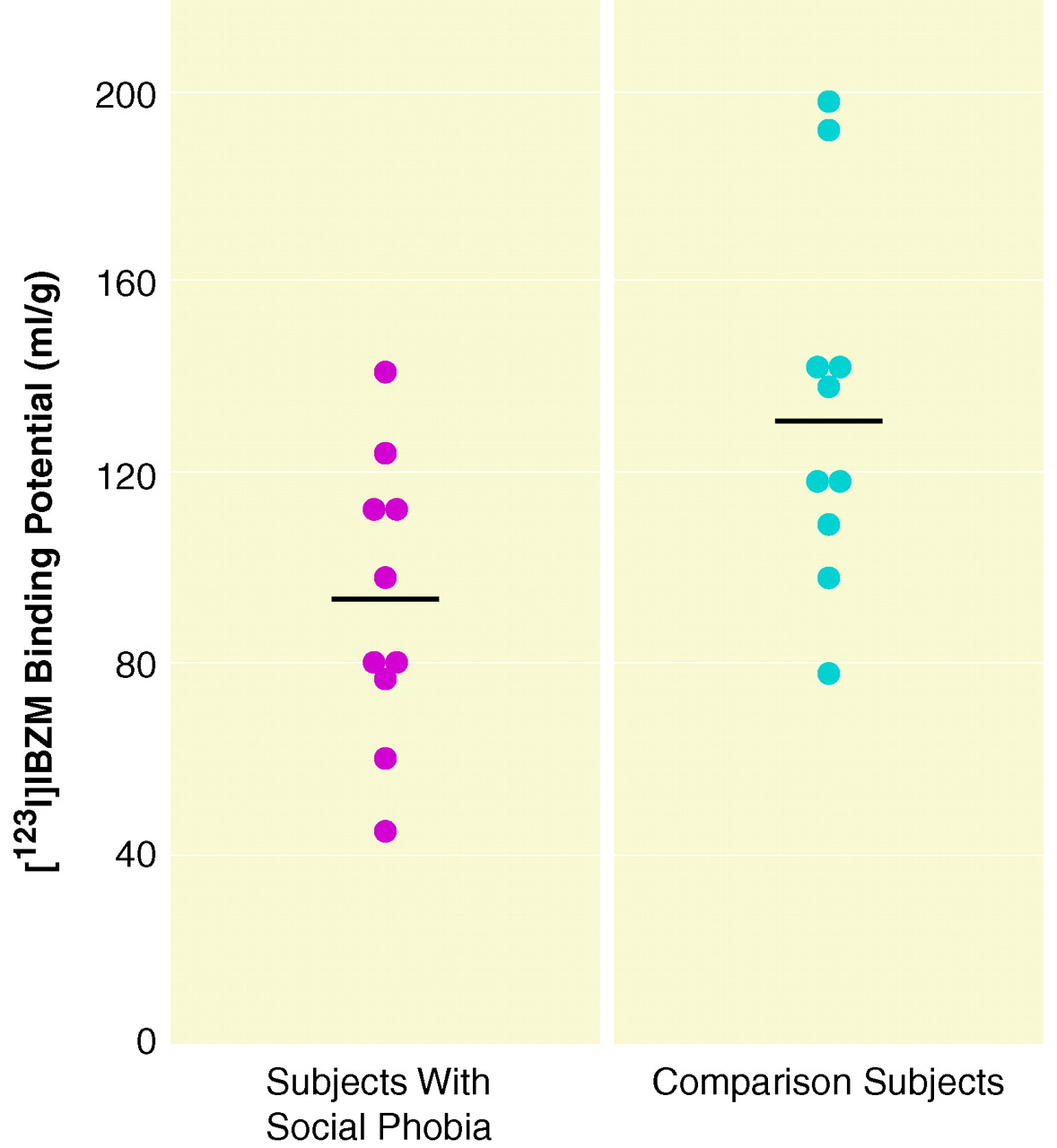The generalized subtype of social phobia, characterized by fear and/or avoidance of most social situations, is chronic
(1), is heritable
(2), and may share behavioral features with subordinate social status in animals
(3), yet the biology of social phobia has been little studied. Evidence for an association of social phobia with subnormal transmission in the dopamine system includes treatment efficacy for monoamine oxidase inhibitors but not tricyclic antidepressants
(4), low dopamine transporter density in generalized social phobia
(5), low CSF levels of homovanillic acid among panic disorder patients with comorbid social phobia
(6), a high rate of social phobia among patients with Parkinson’s disease
(7), and increased social phobia symptoms during haloperidol treatment of patients with Tourette’s syndrome
(8).
In this study we compared dopamine D2 receptor binding potential in patients with generalized social phobia and healthy comparison subjects.
METHOD
Ten subjects with social phobia were recruited by advertisement and clinical referrals; their mean age was 32.5 years (SD=10.4), and the group comprised five men and five women. All subjects were physically healthy as determined by complete medical evaluation, with no current or lifetime psychosis, organic mental disorders, major depression, bipolar disorder, panic disorder, obsessive-compulsive disorder, posttraumatic stress disorder, eating disorders, attention deficit hyperactivity disorder, substance abuse or dependence, schizotypal or borderline personality disorder, or family history of schizophrenia. Ten healthy comparison subjects, matched by age and sex and with no current or past mental disorders, were recruited by advertisement. Diagnoses were confirmed by using the Structured Clinical Interview for DSM-IV Axis I Disorders
(9).
All subjects had been free of psychotropic medication for at least a year, and a drug screen was performed before scanning. After complete description of the study to the subjects, written informed consent was obtained.
The Liebowitz Social Anxiety Scale
(10) was used to measure the severity of social phobia. D
2 receptor binding potential was measured by using the radiotracer [
123I]iodobenzamide ([
123I]IBZM) with single photon emission computerized tomography, by means of the bolus plus constant infusion method, as previously described
(11). A standard region-of-interest profile of constant size and shape was used to analyze the studies. Right and left striatal regions and occipital regions were positioned on summed images. Specific binding was calculated as the difference between striatal activity and occipital activity at equilibrium. [
123I]IBZM binding potential (in ml/g), corresponding to the product of the free receptor density (B
max, in nM or picomoles per gram of brain tissue) and affinity (1/K
D, in 1/nM or milliliters of plasma per picomole of [
123I]IBZM), was calculated as the ratio of striatal specific binding (in microcuries per gram of brain tissue) to steady-state free unmetabolized plasma tracer concentration (in microcuries per milliliter of plasma)
(12).
The group comparisons used two-tailed unpaired t tests with an alpha of 0.05. Binding potential was related to clinical severity by means of rank-transformed data (Spearman rank correlation).
RESULTS
There were no significant group differences in age, sex, race, education, marital status, or handedness.
There was a significant difference in [
123I]IBZM binding potential between groups (t=2.6, df=18, p=0.02), with lower binding potential in the patients with generalized social phobia (mean=93.6 ml/g, SD=29.8) than in the comparison subjects (mean=133.5 ml/g, SD=38.2) (
figure 1). Within the social phobia group, there was a nonsignificant negative correlation of binding potential with the total score on the Liebowitz Social Anxiety Scale (r
s=–0.59, N=10, p=0.07).
DISCUSSION
These findings suggest that generalized social phobia may be associated with low D2 receptor binding potential in the striatum. Low D2 receptor binding potential would be consistent with the findings of low dopamine system activity in social phobia.
This study is limited by the small number of subjects. Also, because only one high-specific-activity experiment was performed with each subject, D2 receptor density and affinity could not be measured.
The findings appear to parallel those from animal studies of subordinate social status, which has been suggested to share behavioral features with human social phobia
(3). For example, a recent positron emission tomography study of female cynomolgus monkeys
(13) showed lower striatal D
2 binding in subordinates, similar to our finding in generalized social phobia. Animals of subordinate social status may be a useful model for understanding the brain function underlying human social phobia.
Low D
2 receptor binding seems at least partially specific to social phobia, rather than representing a nonspecific correlate of stress or mental disorder. D
2 binding has not been found to be low in schizophrenia
(14) or major depression
(15). It has been reported to be low in substance abuse disorders
(16), which may often be comorbid with social phobia
(17).
These data suggest that low D2 receptor binding potential might be associated with social phobia. Combined with results from other centers, these data add to the growing evidence that D2 receptor function modulates social behavior in humans.


